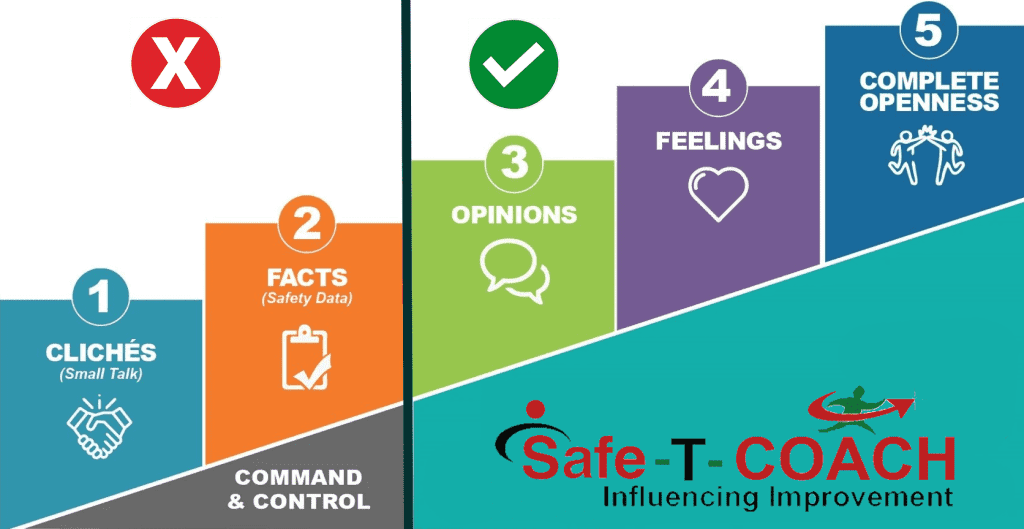
The SAFE-T-COACH© Module
SAFE-T-COACH
Safety coaching goes beyond traditional procedural based training programs by providing ongoing guidance, support, and reinforcement of safe behaviors. It is a powerful tool that empowers employees to take ownership of their safety, enhances their decision-making abilities, and fosters a culture of continuous improvement.
The SAFE-T-COACH© Program is a key element of the SAFE-T-SOS© Psycho-Behavioural Technologies. To see a little more about the SAFE-T-SOS© Psycho-Behavioural Technologies just click here. The SAFE-T-COACH© Program is regularly introduced in partnership with the SAFE-T-VIEW© Observational Protocol. That is because of our fundamental belief that the POWER of a self-sustaining behavioural observation program is the application of the “T” – Transformational Safety® Leadership (TSL) competencies.

Responsible organizations cannot rely solely on their management team or their professional safety personnel to coach and communicate safety and occupational health issues. Long term success depends on leaders who can develop partnerships with team members to address vital safety issues. SAFE-T-COACH© is designed to train participants with practical and effective coaching skills that can be applied when influencing others, working through obstacles, and creating a shared commitment to safety issues.
Integration of the SAFE-T-COACH© competencies shall result in:-
Individualized Guidance and Support:
Safety coaching offers personalized guidance and support tailored to individual employees and their specific job roles. It goes beyond a one-size-fits-all approach, recognizing that each person faces unique challenges and risks in their work environment. Through one-on-one coaching sessions, safety coaches can address employee concerns, provide practical advice, and help individuals navigate potential hazards effectively. This personalized approach increases employee engagement and encourages them to actively participate in creating a safer workplace.
Behavioural Reinforcement and Accountability:
While training programs focus on imparting knowledge, safety coaching focuses on reinforcing safe behaviors and holding individuals accountable for their actions. Coaching sessions provide opportunities for discussions on safety-related topics, reviewing near-miss incidents, and analyzing potential improvements. Safety coaches can identify patterns, correct unsafe behaviors, and reinforce positive practices through constructive feedback and ongoing support. By establishing accountability, safety coaching ensures that employees consistently prioritize safety in their daily activities.
Empowering Employees to Make Safe Decisions:
Safety coaching plays a crucial role in empowering employees to make informed decisions regarding their safety. Coaches equip individuals with critical thinking skills and the ability to assess risks and hazards independently. They encourage employees to voice concerns, ask questions, and actively participate in safety initiatives. By involving employees in the decision-making process, safety coaching empowers them to take ownership of their safety and that of their colleagues, leading to a more proactive and vigilant workforce.
Cultivating a Culture of Continuous Improvement:
Safety coaching fosters a culture of continuous improvement by encouraging employees to identify and address safety gaps and opportunities for enhancement. Coaches work closely with employees to identify potential hazards, analyze incident trends, and develop strategies for prevention. Regular coaching sessions provide a platform for open communication and feedback, allowing employees to contribute their insights and suggestions for improving safety practices. This collaborative approach instills a sense of ownership and engagement, as employees become actively involved in creating a safer work environment.
Enhanced Organizational Performance and Reputation:
Investing in safety coaching delivers substantial benefits to organizations, extending beyond employee well-being. A strong safety culture resulting from coaching programs leads to fewer accidents, injuries, and subsequent downtime. As employees develop a heightened awareness of safety protocols and best practices, productivity and efficiency increase. Furthermore, organizations that prioritize safety coaching cultivate a positive reputation, attracting and retaining top talent, as employees value a work environment that prioritizes their well-being.
SAFE-T-COACH© becomes an invaluable component of a comprehensive safety program in the workplace. By providing personalized guidance, reinforcing safe behaviours, empowering employees, and fostering a culture of continuous improvement, SAFE-T-COACH© ensures that safety becomes an intrinsic part of an organization’s DNA. Investing in safety coaching not only protects employees from potential hazards but also enhances organizational performance, reputation, and employee satisfaction. Ultimately, SAFE-T-COACH© sets the stage for a secure, engaged, and successful workforce.

If you are intereters in the rigours of determing the Return on Invesment of any of your coaching intervetionsn then there is great value in reviewing the metholodgy offered by Forbes Business Magazine. Just click here.
“Most organizations operate in failure states and that just remains invisible because bad stuff is not happening. We might call that the ‘normalization of deviance’ and, make no mistake, it will kill.”

Ricky, Atlanta
![]()
“I was fortunate to attend Transformational Safety’s Anatomies of Disaster Program. This was amongst the most powerful two days I have ever spent in a room. From the outset David Broadbent set the scene by dedicating the program to the late Rick Rescorla – the man who is credited with saving over 2700 lives on 9/11. Throughout the two days David would often respectively reflect and remember those who had died, or been injured, in the disasters we explored. He would say, and I will never forget, “…we must always remember those that lost their lives lift us up into the light of understanding”. I learnt so much. HRO, Resilience Engineering, Critical Incident Stress Management (CISM) and more. Those of us who were there are still talking about it…… Thankyou David


